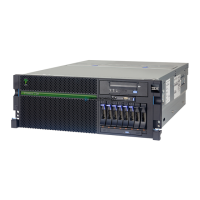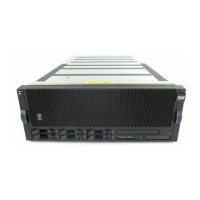Chapter 2. Architecture and technical overview 111
The Power 720 and the Power 740 comply to the ASHRAE Class A3 standard and can
support up to 35 degrees C and 1825 meters at the rated performance. However, they can
operate in a degraded performance above 35 degrees C up to 40 degrees C, or higher,
altitudes.
Processor folding
Processor folding is a consolidation technique that dynamically adjusts, over the short
term, the number of processors available for dispatch to match the number of processors
demanded by the workload. As the workload increases, the number of processors made
available increases. As the workload decreases, the number of processors that are made
available decreases. Processor folding increases energy savings during periods of low to
moderate workload because unavailable processors remain in low-power idle states (nap
or sleep) longer.
EnergyScale for I/O
IBM POWER7 and POWER7+ processor-based systems automatically power off the
hot-pluggable PCI adapter slots that are empty or not being used. System firmware
automatically scans all pluggable PCI slots at regular intervals, looking for those that meet
the criteria for being not in use and powering them off. This support is available for all
POWER7 and POWER7+ processor-based servers and the expansion units that they
support.
Server power down
If overall data center processor utilization is low, workloads can be consolidated on fewer
numbers of servers so that some servers can be turned off completely. Consolidation
makes sense when there will be long periods of low usage, such as weekends. Active
Energy Manager (AEM) provides information, such as the power that will be saved and the
time needed to bring a server back online, that can be used to help make the decision to
consolidate and power off. As with many of the features that are available in IBM Systems
Director and AEM, this function is scriptable and can be automated.
Partition power management
Available with Active Energy Manager 4.3.1 or later, and POWER7 systems with the 730
firmware release or later, is the capability to set a power savings mode for partitions or the
system processor pool. As in the system-level power savings modes, the per-partition
power savings modes can be used to achieve a balance between the power consumption
and the performance of a partition. Only partitions that have dedicated processing units
can have a unique power savings setting. Partitions that run in shared processing mode
have a common power savings setting, which is that of the system processor pool. The
reason is because processing unit fractions cannot be power-managed.
Similar to system-level power savings, two Dynamic Power Saver options are offered:
– Favor partition performance
– Favor partition power savings
You must configure this setting from Active Energy Manager. When dynamic power saver
is enabled in either mode, system firmware continuously monitors the performance and
utilization of each of the computer's POWER7 or POWER7+ processor cores that belong
to the partition. Based on this utilization and performance data, the firmware dynamically
adjusts the processor frequency and voltage, reacting within milliseconds to adjust
workload performance and also deliver power savings when the partition is underused.
In addition to the two dynamic power saver options, the customer can select to have no
power savings on a given partition. This option will keep the processor cores assigned to
the partition running at their nominal frequencies and voltages.
A power savings mode, referred to as
inherit host setting, is available and is applicable
only to partitions. When configured to use this setting, a partition adopts the power
